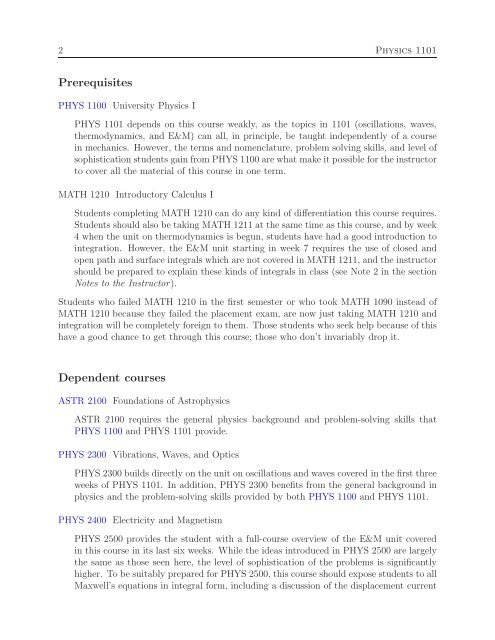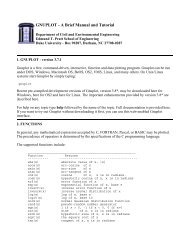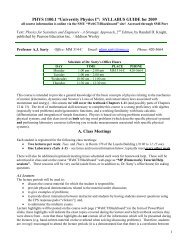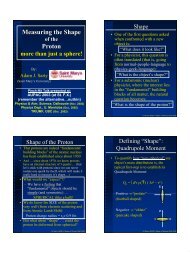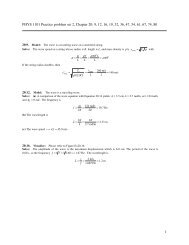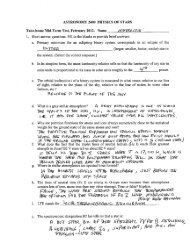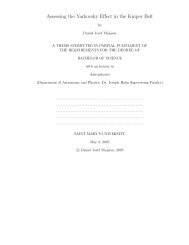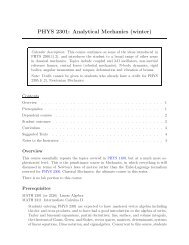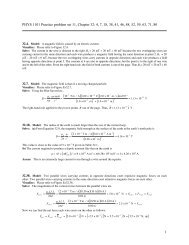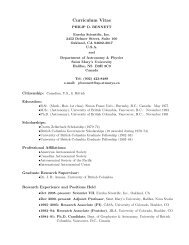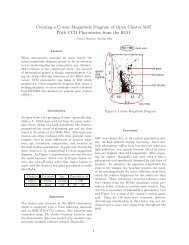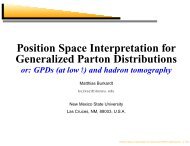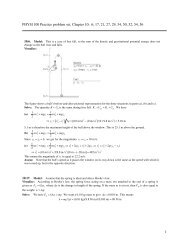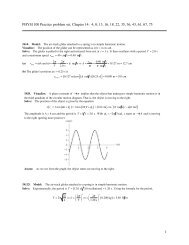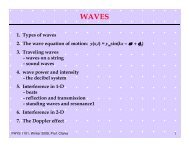PHYS 1101: University Physics II (winter)
PHYS 1101: University Physics II (winter)
PHYS 1101: University Physics II (winter)
Create successful ePaper yourself
Turn your PDF publications into a flip-book with our unique Google optimized e-Paper software.
2 <strong>Physics</strong> <strong>1101</strong><br />
Prerequisites<br />
<strong>PHYS</strong> 1100 <strong>University</strong> <strong>Physics</strong> I<br />
<strong>PHYS</strong> <strong>1101</strong> depends on this course weakly, as the topics in <strong>1101</strong> (oscillations, waves,<br />
thermodynamics, and E&M) can all, in principle, be taught independently of a course<br />
in mechanics. However, the terms and nomenclature, problem solving skills, and level of<br />
sophistication students gain from <strong>PHYS</strong> 1100 are what make it possible for the instructor<br />
to cover all the material of this course in one term.<br />
MATH 1210 Introductory Calculus I<br />
Students completing MATH 1210 can do any kind of differentiation this course requires.<br />
Students should also be taking MATH 1211 at the same time as this course, and by week<br />
4 when the unit on thermodynamics is begun, students have had a good introduction to<br />
integration. However, the E&M unit starting in week 7 requires the use of closed and<br />
open path and surface integrals which are not covered in MATH 1211, and the instructor<br />
should be prepared to explain these kinds of integrals in class (see Note 2 in the section<br />
Notes to the Instructor).<br />
Students who failed MATH 1210 in the first semester or who took MATH 1090 instead of<br />
MATH 1210 because they failed the placement exam, are now just taking MATH 1210 and<br />
integration will be completely foreign to them. Those students who seek help because of this<br />
have a good chance to get through this course; those who don’t invariably drop it.<br />
Dependent courses<br />
ASTR 2100 Foundations of Astrophysics<br />
ASTR 2100 requires the general physics background and problem-solving skills that<br />
<strong>PHYS</strong> 1100 and <strong>PHYS</strong> <strong>1101</strong> provide.<br />
<strong>PHYS</strong> 2300 Vibrations, Waves, and Optics<br />
<strong>PHYS</strong> 2300 builds directly on the unit on oscillations and waves covered in the first three<br />
weeks of <strong>PHYS</strong> <strong>1101</strong>. In addition, <strong>PHYS</strong> 2300 benefits from the general background in<br />
physics and the problem-solving skills provided by both <strong>PHYS</strong> 1100 and <strong>PHYS</strong> <strong>1101</strong>.<br />
<strong>PHYS</strong> 2400 Electricity and Magnetism<br />
<strong>PHYS</strong> 2500 provides the student with a full-course overview of the E&M unit covered<br />
in this course in its last six weeks. While the ideas introduced in <strong>PHYS</strong> 2500 are largely<br />
the same as those seen here, the level of sophistication of the problems is significantly<br />
higher. To be suitably prepared for <strong>PHYS</strong> 2500, this course should expose students to all<br />
Maxwell’s equations in integral form, including a discussion of the displacement current


